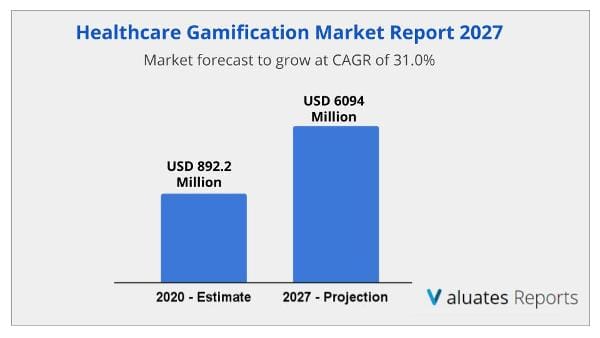
The global Healthcare Gamification market size is projected to reach USD 6094 Million by 2027, from USD 892.2 Million in 2020, at a CAGR of 31.0% during the forecast period 2021-2027. Due to benefits such as more valuable patient data and cost-effective ways to keep patients more motivated and on track with their medication, fitness, and training, the healthcare gamification market is expected to grow. People dislike working out for a variety of reasons, including repetition, no discernible progress, and boredom. Gamification eliminates these issues.

In addition, the rise in the number of lifestyle diseases requiring daily treatment is expected to fuel the healthcare gamification market.
The gamification market is expected to grow in response to the growing demand for gamification in fitness management. Sedentary gamers who enjoy video games for their creativity and challenges will enjoy gamification. Fitness may seem pointless or a means to an end to those who enjoy the immersive stories of video games; however, by incorporating game-like competition, there is a clear goal to strive for. It elevates the game above working out, which many people find difficult to enjoy on its own. With gamification, many of the things people dislike about working out are eliminated, such as repetition, no discernible progress, and boredom. When fitness and games are combined, there are more motivation, interest, and feelings of accomplishment. Gamification has become a popular fitness trend thanks to wearables, apps, virtual reality, and classes.
Helping patients better understand their chronic conditions and simplifying medication management with gamification can improve patient compliance rates and lead to better outcomes. Gamification techniques can make the tedious and repetitive tasks of chronic illness treatment more enjoyable and rewarding. Patients can use gamified apps to manage their health in a more efficient and enjoyable manner. They also allow them to be recognized for their efforts and compete with one another in a positive way. This factor is expected to propel the gamification market forward.
Gamification in medical education aids medical students and professionals in their learning. This factor is expected to propel the Healthcare Gamification market forward. Quiz-based games have been very successful in the medical classroom. For example, a quiz-based clinical neurophysiology game has been shown to significantly improve residency in-service exam scores. PGY2 general surgical residents used quiz-based learning games with similar results. In this case, long-term learning was clearly enhanced.
Attractiveness, motivation, and engagement motivate the use of computer games in physical therapy, but these factors do not guarantee that the interventions will have the intended therapeutic effect. These characteristics are important variables in physical therapy interventions because they involve reward-related dopaminergic systems in the brain, which are known to facilitate learning through the long-term potentiation of neural connections. Gamification has proven to be a cost-effective tool for encouraging patients to complete their exercises even when they are not under the supervision of their physical therapist. A cloud-based dashboard can be used to determine a patient's exercise routine. As a result, the growing use of Physical Therapy is expected to propel the Healthcare Gamification market forward.
Hypertension, diabetes, dyslipidemia, and being overweight or obese are all major risk factors for cardiovascular disease. As a result of rapid economic development and increasing westernization of lifestyle in recent decades, the prevalence of these diseases has reached alarming proportions among Indians. Because of the unprecedented rise in lifestyle diseases, there is a growing demand for apps and games that track these health conditions, resulting in the emergence of a new gamification segment in healthcare for lifestyle diseases. Gamification is seen by many healthcare professionals as an important component of patient engagement, wellness adherence, and improved outcomes. As a result, the Healthcare Gamification market is expected to grow.
Based on type, The enterprise-based user segment will be the most profitable. As a result of the various benefits provided by the employer, employee participation in gamification events has increased significantly in recent years.
Based on application, The most profitable segment is expected to be fitness management. The primary driver of this growth is the increase in the number of health and fitness-conscious people, as well as the increased use of fitness healthcare apps.
Due to the region's growing population, particularly in India and China; increasing smartphone adoption; and growing gamification and creative innovation initiatives, the gamification healthcare market in the Asia Pacific is also seeing significant growth.
The report lists the major players in the regions and their respective market share on the basis of global revenue. It also explains their strategic moves in the past few years, investments in product innovation, and changes in leadership to stay ahead in the competition. This will give the reader an edge over others as a well-informed decision can be made looking at the holistic picture of the market.
|
Report Metric |
Details |
|
Report Name |
Healthcare Gamification Market |
|
The market size in 2020 |
USD 892.2 Million |
|
The revenue forecast in 2027 |
USD 6094 Million |
|
Growth Rate |
CAGR of 31.0% |
|
Base year considered |
2020 |
|
Forecast period |
2021-2027 |
|
Forecast units |
Value (USD) |
|
Segments covered |
Type, End-User, Offerings, and Region |
|
Report coverage |
Revenue & volume forecast, company share, competitive landscape, growth factors, and trends |
|
Geographic regions covered |
North America, Europe, Asia Pacific, Latin America, Middle East & Africa |
Ans. The global Healthcare Gamification market size is projected to reach US$ 6094 million by 2027, from US$ 892.2 million in 2020, at a CAGR of 31.0% during the forecast period 2021-2027.
Ans. Some key players operating in the healthcare gamification market are Microsoft, Under Armour, Strava, Inc. Adidas, Apple, Fitbit, Jawbone, Nike
Ans. Yes, the report includes a COVID-19 impact analysis. Also, it is further extended into every individual segment of the report.
TABLE OF CONTENT
$3350
$6700
HAVE A QUERY?
OUR CUSTOMER

Add to Cart
Add to Cart
Add to Cart
Add to Cart